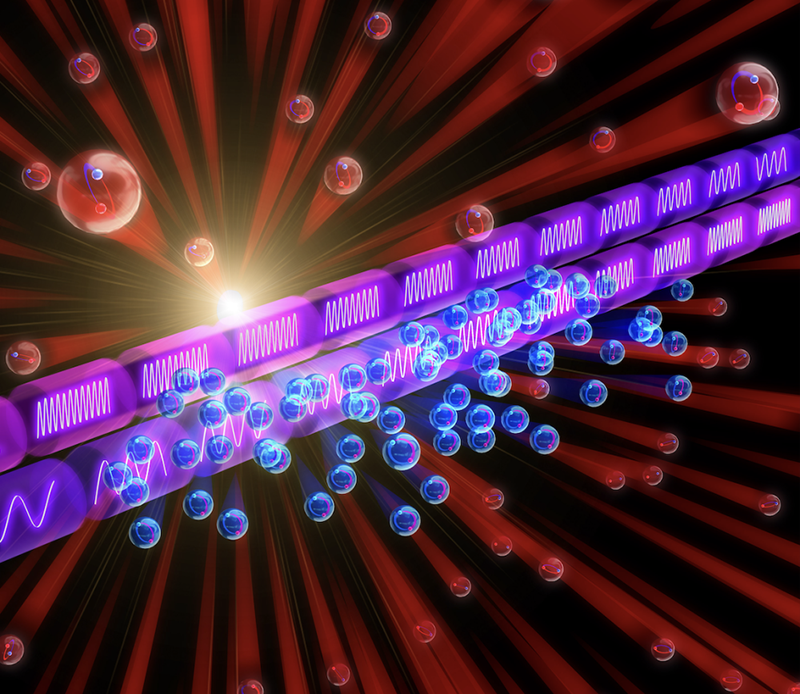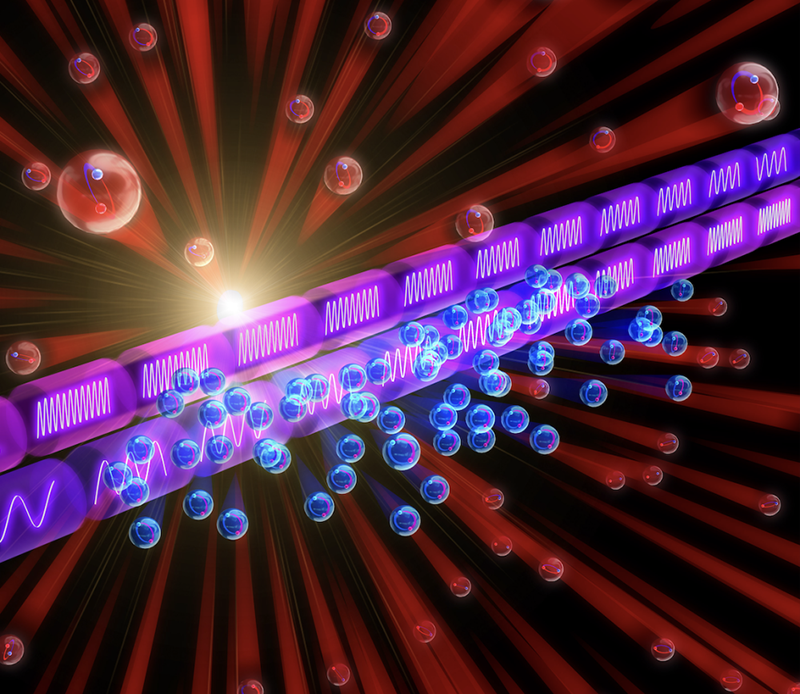Positronium Cooled to Record Low Temperature
Positronium—a simple “atom” consisting of an electron and an antielectron—packs a lot of potential for physics discovery, but unlocking its secrets will require cooling it to near absolute zero. In a step toward this goal, researchers have used a “chirped” laser to slow down positronium atoms in one direction, achieving an effective temperature of 1 K, a cold record for positronium gas [1]. If the method can be extended to three dimensions, the resulting ultracold positronium could be used to generate gamma rays for medical purposes or to perform experiments that might answer fundamental questions about the origin of matter’s dominance over antimatter in our Universe.
A matter–antimatter atom might seem like an unnecessarily complicated choice for studying fundamental physics problems. But normal atoms, like hydrogen, are relatively messy, with their electrons buzzing around a nucleus filled with quarks and gluons. Positronium is a cleaner system made up of just two particles whose interactions can be precisely predicted by the quantum theory of the electromagnetic force, called quantum electrodynamics (QED). Theorists can use QED to predict positronium’s behavior to a persnickety level of precision of 10−10, and any observed deviation from those predictions could be a sign of new physics, such as the existence of dark matter particles. “Precise measurements of positronium might also allow us to find a tiny particle–antiparticle asymmetry, which might explain why antimatter disappeared while matter remained in our Universe,” says Kosuke Yoshioka from the University of Tokyo.
To make such precise measurements, researchers first need to lower the temperatures of positronium gas samples so that thermal effects don’t significantly muddle the measurements. But cooling positronium is not an easy job, as this matter–antimatter concoction is “not long for this world.” Positronium’s electron and antielectron will annihilate each other within about 142 ns after positronium forms. Such a short lifetime doesn’t allow for a slow cooling method, such as putting positronium next to something cold and waiting for the heat to transfer.
A faster option would be laser cooling, in which a gas of atoms is illuminated with laser light. The laser’s frequency is chosen to match an absorption frequency for the atoms (technically, the laser is “red detuned” to have a slightly smaller frequency than the atoms). When an atom absorbs the laser light, it receives a backward push that slows it down along the direction of the laser beam. The problem for positronium is that it weighs a 1000 times less than normal atoms. The smaller mass means each push from the laser causes a large change in the speed and a correspondingly large change in the absorption frequency. This speed-related frequency change—or Doppler shift—makes it difficult to target the positronium with a single-frequency laser. One solution is to use a broad-spectrum laser, as the AEgIS (Antihydrogen Experiment: Gravity, Interferometry, Spectroscopy) Collaboration at CERN demonstrated earlier this year by cooling positronium to 170 K (see Synopsis: Laser-Cooling Positronium).
Yoshioka and his colleagues pursue a different strategy that relies on a chirped laser, one whose frequency changes over time. The team’s unique chirping method controls the frequency of a pulsed laser by coupling it to a second laser beam [2]. The researchers previously showed that this “injection-locked” configuration—combined with a frequency-tuning element called an electro-optic modulator—produces a train of laser pulses with a time separation and frequency change between successive pulses of 4.2 ns and 2 GHz, respectively. “This is a new frequency-control method,” Yoshioka says.
The researchers have now applied their chirped laser to a positronium gas. This gas was created by extracting a small bunch of antielectrons from a particle accelerator and injecting them into a silica aerogel. Inside the aerogel, some of these antielectrons find a “willing” electron and form a positronium union. The team estimates that this process results in a gas of about 1000 positronium atoms, which subsequently diffuse out of the aerogel. Using a laser probe, the researchers measured the initial temperature of their positronium gas to be a balmy 610 K.
To cool this gas, Yoshioka and colleagues used their chirped-laser system, setting it to target the 1S–2P transition in positronium. In hydrogen, this transition corresponds to the Lyman-alpha line at an ultraviolet wavelength (121 nm). Because of positronium’s lighter mass, this 1S–2P transition occurs at a slightly lower energy, corresponding to 243 nm. By tuning their chirped pulses accordingly, the researchers could step down the speed of the positronium atom. “We designed the repetition period of the pulses to enable many cooling cycles during the lifetime of positronium,” Yoshioka says.
When they reprobed the gas after the cooling cycles, they found that the atoms had been decelerated along the laser beam’s direction, resulting in a velocity distribution that corresponds to a temperature of 1 K. The next step will be to apply laser cooling in three dimensions. Adding in the necessary laser equipment should be straightforward, Yoshioka says, but the problem is that 3D cooling will take more time—something that positronium doesn’t have. His group and others are looking into ways to speed up the cooling rates with other laser techniques.
If a positronium gas can be made both cold (< 10 K) and dense (> 1018 atoms per cm3), its atoms are expected to form a quantum state called a Bose-Einstein condensate (BEC). As it self-annihilates, a positronium BEC should generate a coherent pulse of gamma rays, which could be useful in medical imaging and cancer treatment (see Synopsis: Bose-Einstein Condensates for Gamma-Ray Lasers). Studying this gamma-ray emission might also reveal unexpected behavior in the annihilation rate of matter with antimatter, which could provide clues as to why the early Universe went from having roughly equal amounts of matter and antimatter to having mostly matter. Other planned experiments will measure the spectra of positronium transitions, such as the 1S–2S transition, and look for discrepancies with QED calculations that could reveal new particles or the breaking of fundamental symmetries [3]. “We are thrilled at the prospect of conducting such experiments, which might have profound implications for the foundations of elementary physics in the near future,” Yoshioka says.
“Positronium is a great probe for fundamental questions,” says Benjamin Rienäcker, a member of the AEgIS Collaboration from the University of Liverpool, UK. He says the work by Yoshioka and colleagues helps to address Doppler effects in positronium, which have been major limitations to cooling this gas. “With the successful demonstration of an ultracold positronium gas, we are now entering into a fascinating and extremely interesting age of next-generation positronium experiments,” Rienäcker says.
–Michael Schirber
Michael Schirber is a Corresponding Editor for Physics Magazine based in Lyon, France.
References
- K. Shu et al., “Cooling positronium to ultralow velocities with a chirped laser pulse train,” Nature 633, 793 (2024).
- K. Shu et al., “Development of a laser for chirp cooling of positronium to near the recoil limit using a chirped pulse-train generator,” Phys. Rev. A 109, 043520 (2024).
- G.S. Adkins et al., “Precision spectroscopy of positronium: Testing bound-state QED theory and the search for physics beyond the Standard Model,” Phys. Rep. 975, 1 (2022).





